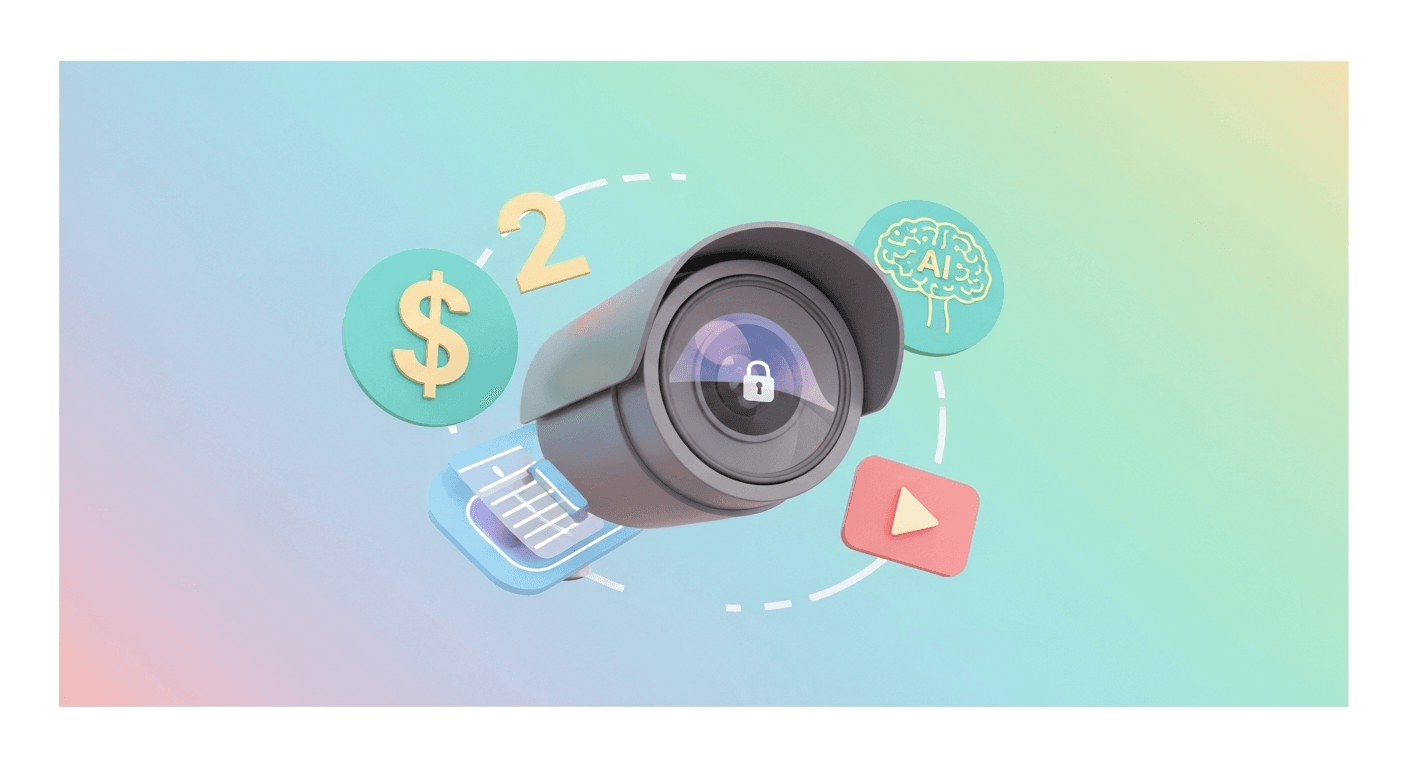Eufy’s $2-per-video AI Training Offer: What Happened, Why It Matters, and How to Protect Your Privacy

Eufy’s $2-per-video AI Training Offer: What Happened, Why It Matters, and How to Protect Your Privacy
Smart home cameras promise to enhance safety for porches and driveways. In late 2024 and early 2025, Eufy—Anker’s home security brand—launched an intriguing initiative inviting customers to contribute to this mission through video submissions of package thefts and car door checks, with the incentive of earning $2 for each approved clip. Interestingly, Eufy specified that staged scenes were acceptable, raising significant debates regarding the value of user data and privacy trade-offs.
The Short Version
- Eufy offered $2 to camera owners for each approved clip showing package theft or attempts to open car doors; staged videos were explicitly allowed.
- The campaign began on December 18, 2024, and included per-device caps, aiming to collect 20,000 clips for each scenario. The end date was later extended to gather more submissions.
- By spring 2025, Eufy community updates indicated potential increases to $5 per theft clip, with caps of up to $250 per camera in certain rounds.
- Besides cash, Eufy runs an ongoing in-app program rewarding donated clips with badges, gift cards, and devices. The app features an Honor Wall leaderboard that highlights prolific contributors.
- The company has a history of scrutiny regarding its encryption practices, which raises questions about trust in its current data collection initiatives.
What Exactly Happened
In mid-December 2024, Eufy launched a community campaign titled “Help Improve Eufy AI! Donate Videos, Earn Cash!” The initiative aimed to collect footage of package thefts and attempts to open car doors. Each approved video would earn users $2, with limits imposed per device to prevent successive submissions from the same camera. Eufy noted that staged scenes were permissible, considering that actual thefts are infrequent yet useful for training detection models. The campaign initially ran from December 18, 2024, to January 25, 2025, with potential extensions if submission targets were not met.
By April 2025, updates on Eufy’s community site mentioned increased rewards in later rounds: up to $5 per theft video, with qualifications capped at 50 events per camera across both types of submissions, potentially allowing earnings of up to $250 per device. Community discussions showcased users comparing rewards and limitations, indicating that payment structures evolved over time as the program continued.
The Program Did Not Stop at Cash
Beyond cash rewards, Eufy’s in-app “Video Donation Program” actively encourages users to share footage for non-monetary benefits, such as badges and gift cards. Users frequently engage in the community to share and compare donation efforts, with an Honor Wall showcasing top contributors—illustrating how some households produce enormous volumes of motion-triggered video. Eufy asserts that donated videos are utilized solely for improving AI systems and are not shared with external parties. Additionally, Eufy invites baby monitor owners to share clips aimed at product troubleshooting, providing directions for footage submission while allowing users to contact support to delete mistakenly donated videos.
Why Would Any Company Pay for Your Home Camera Footage?
AI systems require large, well-labeled datasets. Capture instances of real-life scenarios, like porch thefts or late-night car door checks, are relatively rare. Thus, staged scenes provide a pragmatic solution for training models to recognize specific behaviors—like hand movements and object interactions. Eufy’s allowance of staged clips exemplifies a strategic approach to quickly gather volumes of behavior patterns to enhance its AI capabilities. Media coverage underscored this “fake it till you train it” approach, emphasizing that when genuine incidents are limited, crowdsourcing staged simulations fills the void.
The Privacy and Trust Angle
This initiative occurs amidst a sensitive backdrop. In 2023, Anker admitted that Eufy’s web portal allowed unencrypted video streams, contradicting previous claims regarding end-to-end encryption, and pledged to implement fixes and undergo audits. This experience diminished consumer confidence, making any new data-collection programs subject to heightened scrutiny.
Eufy’s assurances that donated videos will only be used for AI training and not shared with third parties is reassuring, yet critical questions remain. Users often inquire about retention duration, internal access, review processes, and procedures for withdrawing consent. The introduction of payment—no matter how modest—heightens concerns surrounding the distinctions between community science and compensated data collection.
What Eufy Says—and What It Doesn’t
- Allowed Content: Eufy explicitly permitted both real and staged attempts at theft, affirming that acting out scenarios is valid for achieving dataset goals.
- Payout Structure: Initially, users earned $2 per approved clip with device-specific caps. Eufy’s community updates suggested increases to $5 per theft video, along with higher caps in later waves.
- Ongoing Incentives: Eufy’s in-app donation features offer badges, gifts, and leaderboard recognition. They state that donated clips serve to improve AI without sharing data with third parties.
- Baby Monitor Donations: A separate support article illustrates how to donate baby monitor footage, indicating that users can request the removal of mistaken donations if necessary.
How These Datasets Could Be Used, in Plain English
Consider the potential of training a camera system to identify possible porch thefts in real-time. By gathering numerous examples of suspicious behaviors—like hands reaching for packages or people approaching quickly—you enhance the system’s understanding. The variety in lighting, angles, attire, and behaviors improves the model’s accuracy.
Staged clips can expedite this data collection but may unintentionally introduce unrealistic patterns if users act in predictable ways. Nevertheless, when balanced with real incidents, staged videos assist algorithms in learning visual cues, albeit lacking context or intent. Ultimately, these systems excel in pattern recognition rather than understanding human motives.
Should You Participate in Offers Like This?
If you’re considering submitting footage for $2 or $5, weigh the benefits against privacy concerns. Here’s a practical checklist to guide your decisions:
- Read the Rules Thoroughly: Understand what data is collected, who has access to it, retention duration, and how to request deletion later. Take screenshots of the terms for your records.
- Consider Others in Your Clips: Be mindful of who else appears in your footage. Delivery personnel, neighbors, and even family members might be visible. Blurring isn’t always automatic; exercise caution.
- Avoid Risky Staging: Refrain from simulating crimes in ways that could alarm neighbors or attract police attention. Ensure practice scenes are evident and safe.
- Track Your Submissions and Payouts: Maintain a simple log detailing submission dates, filenames, the device used, and promised rewards. Document any changes to program rules impacting submissions.
- Review Your Cloud Settings: Even if processing occurs locally, features like notifications may engage the cloud. Use strong authentication practices and keep firmware updated.
- Know How to Revert a Donation: Familiarize yourself with the procedure to delete already-donated clips. Eufy’s documentation reveals clarity on how to rectify mistakes regarding baby monitor donations.
Why This Story Resonates Beyond One Brand
Compensating users for data—be it phone calls, photos, or home videos—is increasingly common for enhancing AI training without the need for extensive labeling teams. When such data pertains to intimate spaces, user expectations for transparency heighten. People desire clarity about the handling of their footage, applicable protections, and their rights for future control. Successfully addressing these fundamentals fosters trust; mishandling fosters lingering skepticism, particularly for brands with past security issues.
What We Still Don’t Know
- How many clips Eufy collected and retained from the financial campaigns.
- Methods used to determine the authenticity of clips and evaluate quality between staged versus genuine footage.
- Specific retention timelines for donated content and whether any data is shared for model evaluation.
Reporting indicated that Eufy did not address detailed inquiries regarding participant numbers, overall payouts, retention, or deletion following model training, leaving significant gaps in transparency.
Practical Steps if You Already Participated
- Audit Your Account: Review any consent settings or donation history in the app.
- Rotate Your Credentials: Update your password, enable two-factor authentication, and verify device access.
- Minimize Exposure: Adjust motion detection zones and sensitivity settings to reduce unnecessary captures. Consider privacy zones for neighbors’ property.
- Keep Proof: Retain screenshots of promised rewards and the terms applicable during your participation.
Context from Eufy’s Encryption Controversy
Trust is cumulative. In early 2023, The Verge reported that Eufy’s web portal had allowed unencrypted streams, contradicting earlier promises of end-to-end encryption. Following criticism, Anker promised to bolster security and transition to WebRTC. While this history does not inherently discredit current initiatives, it does explain the cautiousness users exhibit toward any new data requests.
Bottom Line
Eufy’s pay-for-clips initiative resides at the intersection of convenience, community safety, and data ethics. For some individuals, $2 to $5 per clip represents a fair trade for assisting in enhancing AI capabilities. For others, the notion of sharing personal video footage with a company—regardless of whether it’s staged—poses significant uncertainties. If you decide to participate in such programs, prioritize your conditions: comprehend the rules, control your data, and maintain documentation of your contributions.
FAQs
Did Eufy Really Pay for Staged Videos?
Yes. Eufy’s submission guidelines confirmed that both real and staged events were suitable for training purposes, with set caps on submissions per device.
How Much Could People Earn?
In initial rounds, payments of $2 for approved clips were standard, with device limitations. Subsequently, community updates suggested payments rising to $5 per theft video in certain waves, with potential earnings of up to $250 per device.
Is There an Ongoing Program Inside the App?
Yes. The in-app Video Donation Program continues to offer non-cash incentives like badges and gifts, alongside an Honor Wall celebrating active donors.
Can I Delete a Clip I Donated by Mistake?
According to Eufy’s support guidance for baby monitor donations, users can contact support to remove mistakenly donated footage. Policies may vary, so it’s advisable to check device-specific instructions.
Why Are Companies Paying for User Videos at All?
AI models require diverse, labeled datasets. In instances where real incidents are scarce, staged clips contribute significant value to training data, although this approach raises discussion around the authenticity of the behaviors captured.
Sources
- Tech reporting summarizing the program’s terms, coverage, and outstanding questions surrounding Eufy.
- Eufy’s community posts detailing the $2-per-clip initiative and submission goals.
- Updates on the program indicating heightened rewards in later rounds.
- Support documentation on donating and removing baby monitor videos.
- Analytical pieces discussing the role of staged clips in training AI systems.
- Background regarding Eufy’s encryption issues and subsequent modifications.
Thank You for Reading this Blog and See You Soon! 🙏 👋
Let's connect 🚀
Latest Blogs
Read My Latest Blogs about AI

California’s New AI Companion Chatbot Law: What SB 243 Changes and Why It Matters
California has enacted SB 243, the first U.S. law for AI companion chatbots. Discover the changes, when it takes effect, and how builders can comply.
Read more


